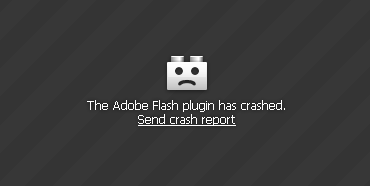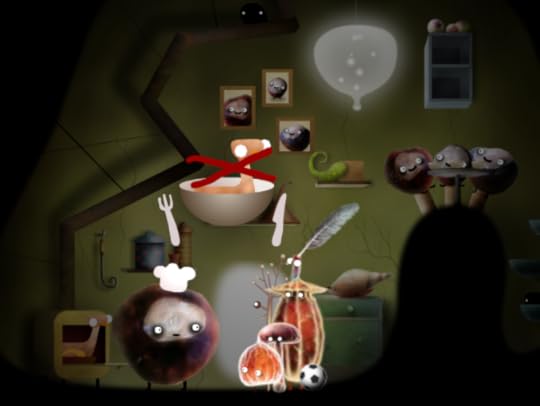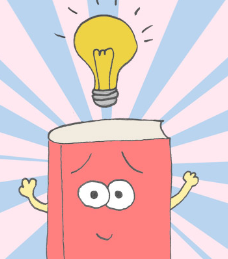André Klein's Blog, page 29
May 9, 2012
A Free Download For German Learners
 People sometimes ask me why I give away books for free.
People sometimes ask me why I give away books for free.
There are many reasons. But the best one is: because I can.
I’m happy to write. And you like to read. So I give, you get. No money has changed hands. Awesome, isn’t it?
For the next few hours you can download the German translation (+ exercises + vocabulary + study instructions) of my recent book “Brian The Book” on Amazon for free!
Amazon UK – Amazon US - Amazon DE – Amazon IT – Amazon FR – Amazon ES
Tell your friends!
P.S.: Also, I finally got my act together and published a few short narratives from the “early days” that survived several HDD-crashes. They’re also in German, and they’re also free for the next 24 hours. Here’s the link. (replace the “.com” with your country-code, if necessary)
P.P.S: For some interesting facts on publishing and being a writer in the year 2012 I got a treat for you on my personal blog.
P.P.P.S.: Since this is not much of a blog post, we’ll follow up tomorrow with an exciting contribution by our guest blogger Henry Fitzgerald. Stay tuned!

 About the author:
André Klein was born in Germany, has grown up and lived in many different places including Thailand, Sweden and Israel. He has produced two music albums, performed and organized literary readings, curated an experimental television program and is the author of various short stories and non-fiction works.
About the author:
André Klein was born in Germany, has grown up and lived in many different places including Thailand, Sweden and Israel. He has produced two music albums, performed and organized literary readings, curated an experimental television program and is the author of various short stories and non-fiction works.
May 6, 2012
Why The Flash Based Virtual Classroom Is A Relic Of The Past

While online learning is more and more becoming a part of our lives, the technology used to deliver online lessons is often lagging behind. Take the virtual classroom for example.
I’ve tried many (free) virtual classroom applications over the years, but none really convinced me.
What is a virtual classroom?
It’s an application (mostly run within a browser) that facilitates online conferences or conversations with streaming audio and video. Sounds simple, doesn’t it?
Apparently, even in the year 2012 running a stable audio/video conference or group session in a browser across a variety of different devices and operating systems proves to be rather difficult.
I’d like to talk a bit today about \options, problems, and possible solutions to the Virtual Classroom issue.
The Standard SettingI first came into contact with Virtual Classrooms through online teaching platforms such as Myngle, EduFire or WiziQ. The way it works is that for listing your courses on their platforms you get to use their Virtual Classrooms during your lessons (for a commission).
In the three examples quoted above, the Virtual Classroom software is proprietary. It’s far from open, in other words. Edufire, for example, used Adobe Connect last time I checked. Myngle and WiziQ have something of their own. The software needs to be licensed. Whether teachers pay for the licensing directly or through teaching platform commissions, someone’s got to pay – which wouldn’t be that bad if the classrooms were actually worth paying for!
Everyone’s trying their best, I know, and I don’t want to go around blaming people, but sometimes it seems to me that although there are millions of students and teachers learning together online, we still don’t have a technology that makes group learning convenient and stable enough to take it seriously. In my own teaching practice I stopped using Virtual Classrooms altogether because of these shortcomings.
More Open AlternativesBesides the aforementioned teaching platforms and their licensed Virtual Classrooms, there are other more open solutions. Here are two examples:
Within a few seconds anyone can quickly start a classroom, connect webcam, microphone and invite people. As far as I’m concerned there are no commissions involved (although you can pay for premium features such as being able to hold larger classes, etc) and the applications are relatively stable.
If it weren’t for one thing…
Yes. Flash.
Flash, My Problem ChildThe late Steve Jobs caused a sensation two years ago when he claimed that “Flash is no longer necessary”. Up to this day, many Apple devices still don’t support it.
Regardless of Jobs’ reasons, it’s a fact that all of the above mentioned classrooms will not run on an iPhone or iPad! Correct me if I’m wrong, but apart from Adobe Connect which was converted into an iOS app, all the others won’t work.
Now, even if we ignore Apple’s distate for Flash, it’s not much rosier for PC/Android users.
Why?
While Flash works well for running little animations, banners, games, etc. it’s a total catastrophe when it comes to running fullfledged applications like Virtual Classrooms within a browser. (By the way: If you want to find out if something is Flash-based, right-click on it. It will tell you, if it is.)
With all the flash-based virtual classrooms that I mentioned above I experienced hiccups on different devices in different circumstances. All it takes is for the screen to freeze and the flash-plugin to crash. Ever seen this little fellow here?

I don’t want to bash Flash in general. It’s great for little apps. But as a productivity tool is rather … counter-productive.
The last thing a teacher needs is for his classroom to crash while in a lesson. A teacher needs to focus on communicating with people. If the screen freezes or he gets locked out of his own session (yes, that actually happens!) then there are serious issues that can’t be fixed by updating or adding more features on the mess which is already there.
Instead, I believe we need to wipe the slate before live online learning in a Virtual Classroom can be taken seriously. The novelty factor of e-learning has worn off. The fact that it work somehow is not enough.
As great as Flash is for other things, in the real of online learning we need something else, entirely!
The Virtual Classroom Of The FutureTo better understand what needs to be done it can be helpful to look at the evolution of whiteboard technology.
They came in all shapes. The first ones were Java-Applets (rather unstable), then came the Flash variety (more stable) and now we have tools like Google Draw and Conceptboard, which use HTML-5 if I’m not mistaken. Even if this new generation is not perfect, either, it’s a lot better than what came before and as anyone who has ever used Google Docs before knows, it’s stable enough to be relied on as a working tool, plus they run on all mobile Apple devices, too.
Now, I ask: where is the Virtual Classroom of the Future that is not Flash-based? Is it even possible?
Conceptboard has just added live streaming video/audio to its features via tokbox, and while that too runs on Flash, at least it’s only the webcam/microphone component and if it crashes, the whiteboard continues.
I think this more modular approach is a step into the right direction. Instead of putting all your eggs into one basket (and making a mess when something goes wrong) having different (relatively independent) modules in a virtual classroom environment may just be the solution…
What are your experiences with Virtual Classrooms? Are they stable enough or not nearly so? I’d love to hear from you.
-

 Some rights reserved by HikingArtist.com
Some rights reserved by HikingArtist.com

 About the author:
André Klein was born in Germany, has grown up and lived in many different places including Thailand, Sweden and Israel. He has produced two music albums, performed and organized literary readings, curated an experimental television program and is the author of various short stories and non-fiction works.
About the author:
André Klein was born in Germany, has grown up and lived in many different places including Thailand, Sweden and Israel. He has produced two music albums, performed and organized literary readings, curated an experimental television program and is the author of various short stories and non-fiction works.
May 2, 2012
Botanicula: The Return Of Creative Adventure Games

I grew up with adventure games. Without characters like Zak McKracken, Guybrush Threepwood, Roger Wilco or Dr. Fred, my childhood is hard to imagine.
Not only did these characters teach me the first meaningful sentences of English outside of an education curriculum, they fed my imagination, humor and curiosity, as well.
I still remember the many days I went to school, looking for that friend who had already solved that brain-wrecking puzzle in Indiana Jones. Yes, when you were stuck back then with an adventure game, you were really stuck. You couldn’t just quickly google “how do I get the mummy up on the roof”. You had to figure it out on your own or ask someone who had already cracked it.
For some reason, adventure games have since then grown out of fashion. In 2000 I remember playing Grim Fandango, and while the 3D graphic was stunning, walking a character around in a three-dimensional environment seemed very different from the old-school method of trying to match the right verb or inventory item with the right point on the screen.
Luckily, there’s Amanita Design, a small independent game developing studio based in Czech Republic.
Their 2009 Machinarium was very much in the tradition of old adventure games, full of pointing and clicking, whimsical characters and hauntingly beautiful 2D graphics, and introduced many younger gamers to this simple but powerful gaming experience.
This year, on April 19th, 2012, Amanita returned with an adventure game that is even weirder, funnier and more beautiful than anything I’ve ever seen: Botanicula.
The story is hard to describe. You are playing a strange bunch of tree creatures: a stick, an acorn-like thing, a fly, a creature with a hat, and a mushroom. The tree they live on is haunted by big black spider-like abominations that literally suck the life-juices out of their home.
Doesn’t sound compelling?
Well…
It’s all in the way graphics, soundtrack, puzzles and character animations work together. Rarely have I seen a more immersive adventure game. The soundtrack is not just some background muzak to fill the silence, it’s the product of Czech band Dva and minutely matches everything that happens in the game, down to the smallest click. Moving your mouse-pointer (or finger, in the touch version) through the undergrowth makes little tinkling sounds, when the creatures solve a riddle, layer after layer is seamlessly added to the music until you’re carried away in sonic bliss.
The puzzles are great, with huge variety, and there’s lots of mini-games to discover, too.
5 stars!
-
originally posted on andreklein.net

 About the author:
André Klein was born in Germany, has grown up and lived in many different places including Thailand, Sweden and Israel. He has produced two music albums, performed and organized literary readings, curated an experimental television program and is the author of various short stories and non-fiction works.
About the author:
André Klein was born in Germany, has grown up and lived in many different places including Thailand, Sweden and Israel. He has produced two music albums, performed and organized literary readings, curated an experimental television program and is the author of various short stories and non-fiction works.
April 29, 2012
Simplicity as Teaching Tool

Working with children taught me that whenever I need to understand (or explain) something, it’s best to start at zero. There’s no need to bring former knowledge, opinions or experience. For adults this is more difficult than children, so it may help to pretend not knowing anything.
This wiping of the slate can help to generate a more natural approach to understanding through simplicity.
Recently, I became aware again of how powerful this is.
Last Friday, my friend and colleague Sylvia Guinan started a new online course for English learners in which she discusses books and movies with her students.
I was glad to see that the first book she picked was my recent children’s book “Brian The Book”.
Unpacking AnalogiesWhile watching the recording, I was amazed how she unpacked layer after layer of this very simple story. I won’t give any spoilers of the story, you can download it here, but it was interesting to see how Sylvia unfolded a whole galaxy of paradigms from this super-simple story, some of which I didn’t even consciously embed into the narrative.
Maybe simplicity is a bit like a vessel which ferries unconscious materials back and forth across the streams of consciousness…
Sometimes, a simple analogy in an image can express more than 4,000 pages of academic prose.
If you want to watch a recording of Sylvia’s conversation class on Friday, click here (the recording is free, but you need a WizIQ account to access it)
here’s a small snippet:
and here’s the accompanying slideshow:
Have a nice day!
And remember to keep it simple!
-
img: CC by Alexander Steinhof

 About the author:
André Klein was born in Germany, has grown up and lived in many different places including Thailand, Sweden and Israel. He has produced two music albums, performed and organized literary readings, curated an experimental television program and is the author of various short stories and non-fiction works.
About the author:
André Klein was born in Germany, has grown up and lived in many different places including Thailand, Sweden and Israel. He has produced two music albums, performed and organized literary readings, curated an experimental television program and is the author of various short stories and non-fiction works.
April 22, 2012
How Ebooks & The Net Bring Us Back To The Middle Ages, In a Good Way
 Recently, I’ve been reading the Gutenberg Galaxy: The Making of Typographic Man, that (in)famous work of Marshall McLuhan, and it struck me that many of his insights relating to print media and reading culture can be applied to what is happening today, exactly 50 years after its publication in 1962.
Recently, I’ve been reading the Gutenberg Galaxy: The Making of Typographic Man, that (in)famous work of Marshall McLuhan, and it struck me that many of his insights relating to print media and reading culture can be applied to what is happening today, exactly 50 years after its publication in 1962.
To summarize, one of the major points that McLuhan seems to be making is that the invention of print is closely connected to a psychological development within man, namely his detribalization and the isolation of a particular way of looking at the world which could be classified as linear and systematical, in the sense of successively removing man from the world in the formation of a new sense of “objectivity”.
In order to understand this better, he takes us on a tour through medieval reading and writing culture which differed significantly from the 20th century outlook on literature but might be experiencing a revival today in the major shift occurring in publishing and reading, as I’d like to show in the following paragraphs.
1. From Isolation To Integration Of The Senses“If a technology is introduced either from within or from without a culture, and if it gives new stress or ascendancy to one or another of our senses, the ratio among all of our senses is altered. We no longer feel the same, nor do our eyes and ears and other senses remain the same.”
McLuhan argues that due to the invention and proliferation of print, the visual sense of man has been (over)stressed to an extent where i becomes isolated. This can be seen in an extreme in the example of speed reading courses where students are taught to disconnect the eyes scanning the text from the inner verbalization, thus speeding up the information intake.
Compared to most modern writing in books and newspapers, in medieval times the writing in manuscripts looked very different, almost as if it wasn’t meant to be read as much as meditated upon.
In addition to the very visceral style of the letters, these manuscripts were full of colorful illustrations and marginalia.
One could argue now that they seem far more visual than our modern blocks of immaculate black & white paragraphs, but it’s true only in a superficial sense. In fact, if we study the way people produced and read these manuscripts, we find that these works were not generated through isolation of the visual but portrayed an integration with all the other senses. These manuscripts were immersive in the truest sense of the word, inviting the reader to participate with heart, mind, body and soul, as it were.
The ebook and the way electronic texts are being published show signs of returning to a more holistic harmony of the senses, at least potentially:
On an e-reader, the fonts, font-size, paragraph spacing are not “set in stone”. They can be adjusted fluidly to the mood and capacity of the reader in any given momentebooks can contain not just illustrations which can be explored by tapping or clicking, they can also contain videos and sometimes have a “text-to-speech” function turning the written words into an electronic spoken performance.by linking and crossreferencing an ebook to the whole body of human knowledge in form of the Internet the isolation of traditional print has become malleable2. Authorship“[T]he Middle Ages for various reasons and from various causes did not possess the concept of ‘authorship’ in exactly the same significance as we have it now. Much of the prestige and glamour with which we moderns invest the term, and which makes us look upon an author who has succeeded in getting a book published as having progressed a stage nearer to becoming a great man, must be a recent accretion. The indifference of medieval scholars to the precise identity of the authors whose books they studied is undeniable. The writers themselves, on the other hand, did not always trouble to ‘quote’ what they took from other books or to indicate where they took it from; they were diffident about signing even what was clearly their own in an unambiguous and unmistakable manner.”
It seems that now in the 21st century we are returning to a state where the author no longer overshadows his work, but where, potentially, the content counts first.
For the last few decades, books have been increasingly connected to their authors. Often, books were only published because their author was a public figure, however marginal. The interest in the person of the author came first, and the text itself was only read because of what it revealed about its author. The very essence of book marketing hinged on the person of the author, promoting the work through talkshows, book signings, etc.This is still very common today, but it seems the significance of authors has reached a climax and is challenged by new modes of electronic publishing
If people like a picture, a song, or an article on the Internet, it is often completely irrelevant who produced it, except for the fact that knowing the source will lead to more and similar works. The blogging platform Tumblr is a good example of this. Something gets reblogged, not necessarily because its author is well-known, but because the image/song/text speaks to the blogger and she wants to proliferate her own experience/opinion/feeling through the medium of the discovered artifact.
Also, in the field of independent book publishing we see a trend where authors need to become ever more creative and inventive to bring their works to a public who doesn’t know or care about the author while potentially being very interested in their works.
The growing disconnection between author and artifact leads to another important issue: copyrights. The burning debates at the moment, as I see them, are not so much about the morality of pirating but rather about the changing entitlement of authors and artists. In a way, it’s already to late for arguments. The fact that we are having these discussions only shows that author and artifact have already lost the cemented relation they enjoyed only a few decades ago.
3. Sharing“To copy and circulate another man’s book might be regarded as a meritorious action in the age of manuscript; in the age of print, such action results in law suits and damages.”
Social Media seems to return us to this more tribal state where “pirating” (in a strict sense, even posting a picture on Facebook or Pinterest is piracy) is not viewn as a perpetration, but as a sign of respect.
It’s also said that if there’d been copyright laws as we have the today in the time of Gutenberg, the printing revolution would never have happened.
The current copyright wars can be understood from three different camps:
artists (and their representatives) who have been popular pre-Internet and demand compensation for the unauthorized reproduction of their works onlinemedia consumers who refuse to pay for something that is also available for freeartists that have grown in and through the Internet who realize that only because people circulate their works can they gain and maintain an audience.We shall see in the following years whether the first group (which is also the older one) will be able to withstand the growing demand and insight of the second two.
But again, the fact that we’re discussing this at such a large scale at the moment only shows that the old mode isn’t working anymore.
While artists and their representatives turn into policemen, prosecuting consumers with the help of Internet providers and governments, a new global tribe is growing which is based on an economy of sharing, substituting the system of direct compensation with more indirect and subtle approaches that make for both an accelerated proliferation of works of art and encourage the production of more.
originally posted on andreklein.net

 About the author:
André Klein was born in Germany, has grown up and lived in many different places including Thailand, Sweden and Israel. He has produced two music albums, performed and organized literary readings, curated an experimental television program and is the author of various short stories and non-fiction works.
About the author:
André Klein was born in Germany, has grown up and lived in many different places including Thailand, Sweden and Israel. He has produced two music albums, performed and organized literary readings, curated an experimental television program and is the author of various short stories and non-fiction works.
April 19, 2012
Introducing Brian The Book (free download inside)

This is the story of a book and its creation:
About a month ago, when I saw that my anarchically drawn short story for German learners found such positive feedback, I decided to try something a bit more refined.
From the beginning the idea was to create a children’s book, something that was highly visual and expressive without too many words. I needed two things: a) a character that was simple enough for me to draw repeatedly and b) a topic. People and animals were out of question from the start: anatomically too difficult. So I started looking for dead-simple inanimate objects.
One day when I was doing the dishes (good place to get ideas) it came to me: books.
I was going to create a character who is a book and make the narrative about the changing role of reading in the 21st century.
From Grey Matter To Digital DeviceOnce this understanding was in place I started sketching with pen and paper. Over the course of the next four weeks these drawings would get revised, scrapped and redone. When I was content with a scene, I picked up a 0.4 black fine-liner and started tracing the outlines. Finally, I scanned all the drawings and colored them digitally while limiting myself to a fixed set of colors to give it a coherent feeling from the first panel to the last.
After that, the digital “book binding” would begin. What binding does an ebook have, you ask? Well, none. But the technical details are relatively boring and I’d rather talk about something else, instead.
Paper Vs. iPadsThe newspapers and blogs these days are full with debates whether ebooks are destroying the book culture or revitalizing it, whether paper or e-ink screens are the best way to read, whether a book needs to have a scent to be enjoyed or not, etc.
I’ve written extensively about these topics myself (see at the end of this post for links) and many times what I read about the topic seemed somewhat…childish, in the sense of obstinately clinging to the status quo. Also, I think the word “childish” is unfair because children often make a lot more sense than adults and we should maybe create a new word: adultish.
In that sense, Brian The Book is a children’s book that tackles the prejudices of adults. By working mainly with images my hope is that the book’s narrative will fly under the radar of logic and encourage alternatives ways of thinking about the subject.
All You Can Read: Get A Free Copy!As usual, we’re kicking off the publication of Brian The Book with a free promotion, which means that you won’t just get a free sample or a brochure, no: You can get the whole book as a free download, no questions asked from Thursday, Apr 19th, 12am to Friday, Apr 20th Monday 23rd 11:59pm Pacific Standard time.
How does it work? Click here to go to the Amazon Kindle Store. And don’t worry, you don’t need a Kindle to read this. There’s a variety of reading apps for every device from iPhone to Android.
Since this is an independent publication and I don’t have millions of dollars to throw to the wind for advertising, I would like to ask you for help. There are many ways in which you can assist, and most of them will just take up a few minutes of your time but will help Brian The Book to soar into the minds and hearts of readers worldwide:
share this article with your friendsClick “like” or “tweet” on Brian’s Smore pagewrite a short review on Amazondownload Brian The Book, make a photo of how it appears on your iPhone, Android, etc and share it here in the comments or on our Facebook pagetell your friends about Brianetc.Thank You!
UPDATE: just received an eye-opening feedback from an 8-year old through Reddit.
watch the trailer or visit Brian’s Smore page now

 About the author:
André Klein was born in Germany, has grown up and lived in many different places including Thailand, Sweden and Israel. He has produced two music albums, performed and organized literary readings, curated an experimental television program and is the author of various short stories and non-fiction works.
About the author:
André Klein was born in Germany, has grown up and lived in many different places including Thailand, Sweden and Israel. He has produced two music albums, performed and organized literary readings, curated an experimental television program and is the author of various short stories and non-fiction works.
April 16, 2012
Small Controlled Bursts Of Boredom: A Cure For Contemporary Click-Frenzies?

“The things people do out of sheer boredom! They study out of boredom; they pray out of boredom; they fall in love, get married and reproduce out of boredom; in the end they die out of boredom.”
It was the German author Georg Büchner who put these words into the mouth of his protagonist in the comedy Leonce and Lena written in 1836. And if we take it literally, the proposition of boredom as the prime motivating force in life (and death) seems like a bad joke.
But before we throw out the baby with the bathwater, let’s put the bias on hold for a second and reconsider the role of boredom in the 21st century.
A Brief Anatomy Of BoredomThe English word ‘boredom’ first appears in Dickens’ novel Bleak House in 1852 and perhaps it is no coincidence that it appeared at a time which also saw a rapid increase of steam-powered engines and mechanical contraptions. Was boredom a new privilege bestowed upon the masses by the rise of machine labor? Did pre-industrial man never get bored, or did he simply lack the vocabulary?
It remains to be seen whether boredom is a symptom of (technological) development or a fundamental part of our psychological furnishing. But at one point or another we all experienced that sensation described by psychologists as “an unpleasant, transient affective state in which the individual feels a pervasive lack of interest in and difficulty concentrating on the current activity.”
Many philosophers have written about the topic, among them Martin Heidegger who has contributed lengthy treatises in which he argues that one should attune oneself to this seemingly negative mood rather than shrug it off in the ordinary understanding:

Isn’t that exactly the attitude we still have towards boredom today? The very idea of it seems to conflict with our notions of purpose and a “fulfilled life”. “Hard-working people don’t get bored,” we say. “They are too busy to get bored.”
Boredom In The Age Of Social MediaClay Shirky recently said something in an interview (which I quoted before) that a lot of people (including myself) can relate to:
I remember, as a child, being bored. I grew up in a particularly boring place and so I was bored pretty frequently. But when the Internet came along it was like, “That’s it for being bored! Thank God! You’re awake at four in the morning? So are thousands of other people!”
When was the last time you felt utterly bored sitting on a train, standing in line, staring out of your window on a grey afternoon? It just doesn’t happen that much anymore, does it? Nowadays people browse their Twitter feeds on their iPhones while standing in line, whack away at the keyboards of their laptops in trains and flood their eyeballs with a constant feed of “all you can eat” movie subscriptions à la Netflix at home.
And maybe what Sam Anderson said about playing games like “Angry Birds” is also true for many other activities now filling the time once occupied by boredom: “They’re less an activity in our day than a blank space in our day; less a pursuit than a distraction from other pursuits.”
Is boredom dying out? Do we need to prescribe small dosages of boredom to escape the vicious cycle of inane activity? Can reading help bridge the states of non-doing and over-doing?
When I was a teenager and had prolonged access to computers for the first time in my life, I began to notice that it was possible to be bored in front of the computer, moving the cursor around my desktop and arranging files and folders in idle patterns. This was pre-Internet.
Later, I found out that it’s also possible to be bored online, mindlessly hopping from link to link, refreshing profiles, numbly scrolling through newsfeeds.
In a sense, as much as I agree with Shirky that we’re experiencing less and less pure boredom, Social Media and the state of “always on, always connected” seems to put us into a condition where we are neither fully experiencing activity or boredom. It’s a hybrid-state of distraction and exhaustion.
And I remember the presenter of the popular German children TV series “Löwenzahn” addressing himself to the audience while the end-credits were rolling: “Now turn off the TV! Do something else!”
It’s not that we heeded his advice, mind you. On the contrary, we mocked him and continued on our inevitable trajectory of media consumption.
But at least it planted the idea in our heads hat there is, in fact, an alternative to electronic activity, one that we’re increasingly losing sight of in the age of microblogging and hypernetworking:

-
img credit: chairs: Some rights reserved by limonada / candle: Some rights reserved by Simon Greig (xrrr)

 About the author:
André Klein was born in Germany, has grown up and lived in many different places including Thailand, Sweden and Israel. He has produced two music albums, performed and organized literary readings, curated an experimental television program and is the author of various short stories and non-fiction works.
About the author:
André Klein was born in Germany, has grown up and lived in many different places including Thailand, Sweden and Israel. He has produced two music albums, performed and organized literary readings, curated an experimental television program and is the author of various short stories and non-fiction works.
April 12, 2012
How Indie Publishing Could Revolutionize Creative Expression But Often Doesn’t

It was Clay Shirky who said in a recent interview that publishing is no longer a job, it’s a button.
In fact, I’m staring at one right now. It’s blue and it says “publish”. It’s simple. Shall I click it? No? But it would make me a world-class publisher, wouldn’t it?
Some people will say yes, others no. I’d say it all depends on how you define “publishing”. But no matter how we define it, we have to admit that it has never been easier for almost anyone to publish almost anything. Needless to say, the content here is irrelevant. To be more precise, the fact that it has become easier to publish something hasn’t automatically made it easier to publish something awesome!
Sure, it may have lowered the bar and allowed people to be heard who otherwise would never have been able to get past the gatekeepers, but it has also brought with it a new tension between convenience and creativity.
When “because I can” is no longer enoughLike many people, when I started my first blog, I was intrigued by the simplicity. I could just write a few words, insert a picture and hit publish. I could do that many times a day, as often as I wanted. Nobody would tell me what to post or what not to post. “My blog was my castle”. This was way before microblogging on Twitter became a daily necessity of digital life, by the way.
Now, almost a decade later, I have sobered up a little. I know how easy it is to publish something and I’m also painfully aware of the millions of blogs that get absolutely zero traffic because they’re full of redundant, inarticulate or irrelevant stuff!
I can do it. But should I?
The English verb can is interesting, but its seeming simplicity is misleading. The French have two words for it, with very different meanings. One of them, pouvoir refers to being able to do something regarding time or circumstance and the other one, savoir, refers to being able to do it as in having learned it
Returning to Clay Shirky’s quote from above, yes, everyone can be a publisher in the sense of pouvoir, because it’s so convenient. But the savoir-faire, or the know-how, as we say in English, is something very different.
Now, I’m aware that measuring competence is a difficult and all too often highly arbitrary endeavor. I leave that up to the professors of publishing 101 classes. Furthermore, I can’t claim that I’m competent, myself. I can only aspire to it. And this is where it gets interesting, because it shifts publication from product to process.
But when anyone can publish anything, what is its value? Are we experiencing a revival of creativity or just a publishing inflation?
More Of The Same And Less Of Something ElseAs Sam Anderson wrote in his brilliant piece about contemporary gaming culture, the production of big video games mimics the Hollywood model of ”imitations, spinoffs, prequels, sequels and even subsequels” because it’s just too risky to produce something new and unique and then not be able to sell it. For the consumer, or gamer this means: more of the same and less of something else.
Fortunately, independent game developers are challenging this model. The games they make don’t require millions of dollars and hundreds of programmers to produce. And therefore, if a game fails, it’s not the end of the world. Some of the most creative games I’ve ever seen were conceived, built and distributed in this new way.To give you an example, check out the Humble Indie Bundle and you’ll see that not just the games are very different but also the whole philosophy around them.
And there are not just indie game developers these days, there are also more and more indie publishers.
When I first heard the term, I was happy to finally have an alternative to the dreaded self-publishing, a close cousin to the horrible vanity-publishing. Indie publishing, that sounded like punk in the 70ies: wild creative expression that answered to noone.
Unfortunately, when you look around the web these days, what is self-advertised as “indie publishing” is often surprisingly dull. Not having a lot of money for editors or stylish covers is not what I mean. These are more or less technical issues. What I’m referring to is the endless amounts of more of the same, less of something else, to be more precise: Harry Potter imitations, Twilight spinoffs, Hunger Games wannabees and endless covers with scantily clad females and males hovered over by an aura of paranormal mystery or kitschy longing.
Yes, I know, it’s tough to make a living from writing, and before you start working on that 900 page novel you want to be at least marginally assured that it will be read, not to mention being sold, so why not just piggyback on what is already out there?
Pulp magazines have always existed and they’ve proven to generate cash. So, instead of being one of a hundred type-monkeys collaborating on the next “Gone With The Wind” spinoff for the supermarket aisles, people now do it individually. As long as it brings cash, this is where being an indie publisher literally pays off for most people, but I believe it hasn’t even begun!
Sure, bills need to be paid somehow. But being an indie publisher means you can do something really wild and uncompromising. Many times it will fail. But the times when it works (and sells) it’s so much better than just driving down imitation lane and making a few pennies along the way.
To give you an example, when I published Peter und das Huhn I couldn’t have cared less what people thought about it. The “drawings” were midwifed onto paper by reckless scrawls on telephone notepads. I thought it was some kind of joke. But it just keeps selling and I recently dropped the price as low as possible because I couldn’t see people spending 2.99 for something I came up with in just a few measly minutes.
My secret guess is that what people like about it is that it’s somewhat reckless. It just is what it is and doesn’t try to be something else.
No, I didn’t get rich from this. But I learned something very important. The fact that I can publish something quickly doesn’t mean that it gets easier to publish something great, but it certainly allows for experimentation and creative development beyond my wildest dreams.
For example, only through this process did I begin to take my scrawling more seriously, eventually came up with an illustrated detective story and an elaborately illustrated children’s book (soon to be released).
I’m going to click the “Publish” button now. Feel free to share this article with your friends or leave a comment below.
[image error]
-
img credit: broken glasses

 Some rights reserved by helena_perez_garcia, publish button by wordpress
Some rights reserved by helena_perez_garcia, publish button by wordpress

 About the author:
André Klein was born in Germany, has grown up and lived in many different places including Thailand, Sweden and Israel. He has produced two music albums, performed and organized literary readings, curated an experimental television program and is the author of various short stories and non-fiction works.
About the author:
André Klein was born in Germany, has grown up and lived in many different places including Thailand, Sweden and Israel. He has produced two music albums, performed and organized literary readings, curated an experimental television program and is the author of various short stories and non-fiction works.
April 8, 2012
How To Break Out Of Your Filter Bubble And Reclaim Search Privacy
 Do you remember the world before Google?
Do you remember the world before Google?
I do, and then again, I don't. Googling has become such an integral part of everyday existence that we aren't really aware of it anymore. We take it for granted that when we type stuff into a search field we get results. And Google does deliver the goods. Rarely do we need to browse through pages 2-3-4, etc.

But apart from getting good results (and learning how to get there) there's another side to Google, a company that is increasingly mining our lives for data.
Escape Being TrackedHave you ever noticed that when you google for something a lot, you'll see advertising for it all over the web?
Each time you do a search on Google, your queries are tracked and connected to advertisers.
It's no secret that Google doesn't even shy away from looking through personal emails, either, all in the name of presenting you with "custom tailored product offers", in other words: ads, ads, ads.
Now, you could say: What do I care? I use an ad-blocker anyway, and never see any ads.
So do I. But, just like with Facebook, there's a looming sense of never quite knowing anymore what kind of information this company has acquired about you over the years.
In other words, Google builds a profile about us consisting of our (gmail) emails, our searches, our friends (on G+), the videos we watch on YouTube and so on and so forth.
When Google Glass becomes a reality, there's a chance that everything we see 24/7 will get logged and archived in HD, ready to be bombarded with ads, requested by state officials, nosy employees or rampant hackers. In that case, running against a lamp pole won't be the biggest problem.
Breaking Out Of The Filter BubbleThe "Filter Bubble" is a concept referring to the phenomenon that when you google for certain things, you'll get more of them and less of everything else.
Trying to satisfy searchers, Google's search results are increasingly personalized. When two people google the same term, they can get radically different results:

Each person has his own Google, so to speak, his bubble. If you don't log out, delete your cookies, etc, this bubble will influence everything you put into the search giant.
And sometimes you have to wonder whether's that's really helpful and enabling people to find what they're looking for quicker or just a trick to keep people clicking on more ads.
Personally, I use a lot of Google products, but recently, taking all of the above into consideration, I replaced my gateway drug into the Google universe with something else.
Yes, I'm talking about the Google search engine. There is an alternative!
Friendly Ducks Instead Of Bubbles And Advertisments

It was a few months ago that I first stumbled across duckduckgo, a search engine that promises to be everything that Google is not, while still delivering excellent search results.
It…
doesn't have advertisingdoesn't save search queriesdoesn't bubble its usersAt first I was sceptical. I was so accustomed to Google that it seemed impossible to switch. But a few days ago I finally replaced my standard search engine with duckduckgo.
What seems like a silly name for a serious search engine is actually a lot of fun.
In a way it feels like re-discovering the Internet anew. And the technology? It delivers great results, and very quickly. This is no hastily pieced together geekatron engine. This thing has wings, and it soars.
And, best of all, using "The Duck" (as my wife and I like to call it) doesn't bar you from using other engines, too. When you aren't happy with its results, you can use still use Google or Bing as secondary choices.
But it's a great feeling not to be dependent on Google. (Almost as good as quitting Facebook)
-
img: bubble
 Some rights reserved by JMMarkiewicz
Some rights reserved by JMMarkiewicz
~
 About the author:
André Klein was born in Germany, has grown up and lived in many different places including Thailand, Sweden and Israel. He has produced two music albums, performed and organized literary readings, curated an experimental television program and is the author of various short stories and non-fiction works.
About the author:
André Klein was born in Germany, has grown up and lived in many different places including Thailand, Sweden and Israel. He has produced two music albums, performed and organized literary readings, curated an experimental television program and is the author of various short stories and non-fiction works.
April 4, 2012
How Interactive Can A Book Become Before It Stops Being a Book?
 After the positive replies I received regarding my 5-minute mini story project, I decided to work on something longer while still staying true to the principle of keeping things short and digestible.
After the positive replies I received regarding my 5-minute mini story project, I decided to work on something longer while still staying true to the principle of keeping things short and digestible.
The result of which I would like to present today.
Text is Great, But Context Is BetterIt all started about one month ago. I had this idea of a detective story for German learners, but I wasn't just thinking in terms of text. Instead, I wanted to build an interactive reading experience that would make the most of currently available e-reading devices.
Ever since Al Gore presented his multimedia ebook last year, people have been prophesizing that the future of the book will not consist of text but will include audio, video and interactive apps.
While that sounds very exciting, we have to be aware that there are actually two general types of ebooks or e-reading experiences at the moment:
The e-ink experience (mostly monochrome and specialized on displaying static text or images without screen glare)LCD screens (think iPad, laptops, smartphones: high resolution screens that can display everything, but not without glare)In my experience at least, the second variety doesn't really lend itself to reading. It's fun to swipe and tap around on a touchscreen, jump through feeds, surf the web and watch videos, but it can't compete with the paper-like feel of e-ink screens when it comes to reading and focusing on (long) texts for prolonged periods of time.
So for me it was clear that for the detective story I would target e-ink screens in general, in particular the Kindle, since it's so widespread.
What kind of interactivity can you get with a screen that's black & white and doesn't do video or animation, you ask?
Surprisingly, a lot, especially when you stop thinking about interactivity in terms of reacting to menu items and clicking/tapping but more in terms of navigating a text both internally and externally i.e. psychologically and motorically. (Keep in mind also that reading itself is a highly interactive experience)
Put simply, I did the following:
create illustrations for each chapter optimized for e-ink screens that encourage visual (and emotional) accessappend vocabulary and multiple choice questions to each chapter in order to enhance text-comprehensionprepare the material in such a way that it can be navigated with a Kindle device and show translations of difficult words directly on screenI'm aware that none of these is really unique or new on their own (except the third maybe) but together they make for a very different experience of immersion.
Test-Drive This Publication: Download it for free!From Wednesday, Apr 4th, 12am to Friday, Apr 6th, 12pm the book will be available as a free download in the Amazon Kindle Store. (The promotion will start at approximately 12:00 AM Pacific Standard Time and end at approximately 11:59 PM Pacific Standard Time)
This is to give as many people as possible the chance to try it out and help improve it (if necessary).
You can get it directly here or by checking out the unique web flyer I built for this publication with a new but very promising tool called Smore. (It's currently in invite-only mode but after a few days of testing I highly recommend it!)
As usual, if you have any feedback on this I'm more than eager to hear about it here in the comments on the blog or in the form of a review over at Amazon. Tell me what you think! If I like your idea, I might integrate it into the next edition! Oh, and you can also comment directly on the Smore page.
-
img: icon by Ola
~
 About the author:
André Klein was born in Germany, has grown up and lived in many different places including Thailand, Sweden and Israel. He has produced two music albums, performed and organized literary readings, curated an experimental television program and is the author of various short stories and non-fiction works.
About the author:
André Klein was born in Germany, has grown up and lived in many different places including Thailand, Sweden and Israel. He has produced two music albums, performed and organized literary readings, curated an experimental television program and is the author of various short stories and non-fiction works.








